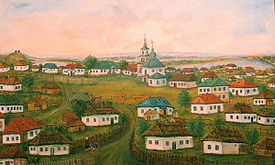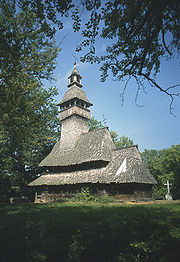
Wooden churches in Ukraine
Encyclopedia

General overview
At the end of 2010 in Ukraine were accounted for some 1900 wooden temples. When Ukrainians emigrated to the new world in the late 19th century, many used these forms but adapted their construction to new materials and new environmental conditions (see e.g. the Holy Trinity Cathedral in Chicago, Illinois). Currently the situation in preservation of these unique churches in Ukraine is very difficult as according to the director of Lviv Art Gallery Borys Voznytsky in the West Ukraine in Soviet times were burnt down less churches than in the post-Soviet period.Wooden Churches of Central and Eastern Ukraine
Wooden church architecture of Central and Eastern Ukraine finds its roots through the first millennium of Christianity in Ukraine, from the time of Vladimir the Great in KievKiev
Kiev or Kyiv is the capital and the largest city of Ukraine, located in the north central part of the country on the Dnieper River. The population as of the 2001 census was 2,611,300. However, higher numbers have been cited in the press....
. While masonry churches prevailed in urban areas, wooden church architecture continued primarily in Ukrainian villages of central and eastern Ukraine. Unlike western Ukraine, there is no clear separation of style based on region. Central Ukrainian churches are similar to the multi-chamber masonry churches of Kievan Rus'
Kievan Rus'
Kievan Rus was a medieval polity in Eastern Europe, from the late 9th to the mid 13th century, when it disintegrated under the pressure of the Mongol invasion of 1237–1240....
, but instead constructed in wood. Both framed construction and nail-less styles are present, as well.
Wooden Churches of Western Ukraine



.jpg)
Ukrainian hryvnia
The hryvnia, sometimes hryvnya or grivna ; sign: ₴, code: , has been the national currency of Ukraine since September 2, 1996. The hryvnia is subdivided into 100 kopiyok. In medieval times, it was a currency of Kievan Rus'....
to finance restoration projects of the churches.
Bukovina
The traditional Bukovinian
Bukovina
Bukovina is a historical region on the northern slopes of the northeastern Carpathian Mountains and the adjoining plains.-Name:The name Bukovina came into official use in 1775 with the region's annexation from the Principality of Moldavia to the possessions of the Habsburg Monarchy, which became...
church features a tall gabled roof, but often terminates in splayed roof over the polygonal sanctuary. The roofwork features opasannia and was covered in wooden shingles. The structure was usually built from logs but was often covered in clay and whitewashed, similar to Bukovinian style homes.
Lemko
Lemko churches most often used a three section church with very tall gabled roofs and a tower over each section with the tower over the entrance being the tallest. Topping each tower is a spire, bearing resemblance to Gothic spires, albeit constructed in Ukrainian style.
Hutsul
Hutsul churches most often were 5 section cruciform churches, using spruce logs to form walls with opasannia type arcades. The central dome is formed in an octahedral shape with a splayed roof, instead of an onion dome.
Also unique to Hutsul churches is the use of tin or metalwork in the upper parts of the church, which are also used in home architecture of the region.
Boyko
Boyko
Boyko
Boyko or Boiko are a distinctive group of Ukrainian highlanders or mountain-dwellers of the Carpathian highlands. The Boykos inhabited the central and the western half of the Carpathians in Ukraine, including the Dolynskyi and a part of the Rozhniativskyi Raions in the Ivano-Frankivsk Oblast ,...
churches are defined by their three section design, with the central nave being the largest. Intricate, multi-tiered and shingled roofwork is the most distinguishing factor in Boyko church design. The structures used the most traditional techniques, being both frameless walls and rafterless roofs as well as using opasannia and piddashshia.
Ternopil
Ternopil
Ternopil
Ternopil , is a city in western Ukraine, located on the banks of the Seret River. Ternopil is one of the major cities of Western Ukraine and the historical region of Galicia...
construction styles are considered a mix of Carpathian style and Kiev styles. Two styles prevail: Ternopil Nave Style and Ternopil Cruciform Style. The nave style used a long rectangular shape with gabled roofing on opposite ends with a small decorative onion dome, often not visible from inside the church. The cruciform style uses an equidistant cruciform pattern with a structural central onion dome, and gabled roofing over each cruciform section. While constructed in wood in villages, this style often used masonry in urban areas.
List Wooden Churches in Ukraine

- Apşiţa (Voditsa in Ukrainian, Felso-Apsa-Apsicza in Hungarian)
- Apşa de Mijloc, Susani (Sredneye Vodyanoye is Ukrainian, Kozep Apsa in Hungarian)
- Apşa de Mijloc, Josani
- Apşa din Jos, Părău (Verkhnye Vodyane is Ukrainian, Also-Apsa in Hungarian)
- Danylovo (Dănileşti in Romanian, Sofalva in Hungarian)
- Dulovo (Duleni in Romanian, Dulfalva in Hungarian)
- Ganychi (Găneşti in Romanian, Ganya in Hungarian)
- Kobyletska Poliana (Poiana Cobilei in Romanian and Gyergyanliget in Hungarian)
- Kolodne (Darva in Romanian and Hungarian)
- Krainykovo (Mihalka in Hungarian, formerly Steblivka between 1919–1938 and 1945–1946, Crainiceni in Romanian)
- Neresnytsia (Nereşniţa in Romanian, Also Neresznicze in Hungarian)
- Nyzhnie Selyshche (Săliştea de Jos in Romanian, Also Szelistye in Hungarian)
- Olexandrivka (Sândreni in Romanian, Sandorfalva in Hungarian)
- Ruska Pole I (Domneştii Mari in Romanian, Urmezo in Hungarian)
- Ruska Pole II
- Sokyrnytsia (Săclânţa in Romanian, Szeklencze in Hungarian)
- Steblivka (Duboşari in Romanian, Szaldobos in Hungarian)
- Ternovo (Târnova in Romanian, Kokenyes in Hungarian)
List Wooden Churches in Zakarpattia OblastZakarpattia OblastThe Zakarpattia Oblast is an administrative oblast located in southwestern Ukraine. Its administrative center is the city of Uzhhorod...

- Sredne Vodyane churches
- Verkhnye Vodyane church
- Danylovo church
- Kolodne church
- Krainykovo church
- Nyzhnie Selyshche church
- Olexandrivka church
- Sokyrnytsia church
See also
- Carpathian Wooden ChurchesCarpathian Wooden ChurchesRoman Catholic wooden church of St. Francis of Assisi in Hervartov has a Gothic character as represented by its tall but narrow structure unusual for a wooden church. It was built in the second half of the 15th century and thus represents the oldest of its type in Slovakia...
- Wooden Tserkvas of Carpathian Region in Poland and UkraineWooden Tserkvas of Carpathian Region in Poland and UkraineWooden Tserkvas of Carpathian Region in Poland and Ukraine are a group of wooden Orthodox churches located in Poland and Ukraine which were proposed for inscription on the UNESCO World Heritage List in 2010.-Nominated tserkvas:-See also:...
- Wooden Churches of Southern Little PolandWooden Churches of Southern Little PolandWooden Churches of Southern Lesser Poland and Subcarpathia of the UNESCO inscription are located in Gorlice, Nowy Targ, Bochnia counties , and Brzozów County and are in Binarowa, Blizne, Dębno, Haczów, Lipnica Dolna, and Sękowa...
- Wooden Churches of the Slovak Carpathians
- Wooden Churches of MaramureşWooden Churches of MaramuresThe Wooden Churches of Maramureş in the Maramureş region of northern Transylvania are a group of almost one hundred churches of different architectural solutions from different periods and areas. They are Orthodox churches. The Maramureş churches are high timber constructions with characteristic...
in Romania - Vernacular architecture of the CarpathiansVernacular architecture of the CarpathiansThe vernacular architecture of the Carpathians draws on environmental and cultural sources to create unique designs.Vernacular architecture refers to non-professional, folk architecture, including that of the peasants...
- Stave churchStave churchA stave church is a medieval wooden church with a post and beam construction related to timber framing. The wall frames are filled with vertical planks. The load-bearing posts have lent their name to the building technique...
, wooden churches of Scandinavia

